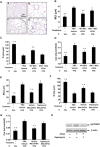Activation of p70S6 Kinase-1 in Mesenchymal Stem Cells Is Essential to Lung Tissue Repair
- PMID: 29730892
- PMCID: PMC6052610
- DOI: 10.1002/sctm.17-0200
Activation of p70S6 Kinase-1 in Mesenchymal Stem Cells Is Essential to Lung Tissue Repair
Abstract
All-trans retinoic acid (ATRA) or mesenchymal stem cells (MSCs) have been shown to promote lung tissue regeneration in animal models of emphysema. However, the reparative effects of the combination of the two and the role of p70S6 kinase-1 (p70S6k1) activation in the repair process have not been defined. Twenty-one days after intratracheal instillation of porcine pancreatic elastase (PPE), MSC and/or 10 days of ATRA treatment was initiated. Thirty-two days later, static lung compliance (Cst), mean linear intercepts (MLIs), and alveolar surface area (S) were measured. After PPE, mice demonstrated increased values of Cst and MLI, and decreased S values. Both ATRA and MSC transfer were individually effective in improving these outcomes while the combination of ATRA and MSCs was even more effective. The combination of p70S6k1-/- MSCs transfer followed by ATRA demonstrated only modest effects, and rapamycin treatment of recipients with wild-type (WT) MSCs and ATRA failed to show any effect. However, transfer of p70S6k1 over-expressing-MSCs together with ATRA resulted in further improvements over those seen following WT MSCs together with ATRA. ATRA activated p70S6k1 in MSCs in vitro, which was completely inhibited by rapamycin. Tracking of transferred MSCs following ATRA revealed enhanced accumulation and extended survival of MSCs in recipient lungs following PPE but not vehicle instillation. These data suggest that in MSCs, p70S6k1 activation plays a critical role in ATRA-enhanced lung tissue repair, mediated in part by prolonged survival of transferred MSCs. p70S6k1-activated MSCs may represent a novel therapeutic approach to reverse the lung damage seen in emphysema. Stem Cells Translational Medicine 2018;7:551-558.
Keywords: Animal models; Cell signaling; Cellular therapy; Mesenchymal stem cells; Tissue regeneration.
© 2018 The Authors Stem Cells Translational Medicine published by Wiley Periodicals, Inc. on behalf of AlphaMed Press.
Figures





Similar articles
-
Reduction of Emphysema Severity by Human Umbilical Cord-Derived Mesenchymal Stem Cells in Mice.Int J Mol Sci. 2022 Aug 10;23(16):8906. doi: 10.3390/ijms23168906. Int J Mol Sci. 2022. PMID: 36012176 Free PMC article.
-
Predifferentiated amniotic fluid mesenchymal stem cells enhance lung alveolar epithelium regeneration and reverse elastase-induced pulmonary emphysema.Stem Cell Res Ther. 2019 Jun 13;10(1):163. doi: 10.1186/s13287-019-1282-1. Stem Cell Res Ther. 2019. PMID: 31196196 Free PMC article.
-
Impact of one versus two doses of mesenchymal stromal cells on lung and cardiovascular repair in experimental emphysema.Stem Cell Res Ther. 2018 Nov 8;9(1):296. doi: 10.1186/s13287-018-1043-6. Stem Cell Res Ther. 2018. PMID: 30409216 Free PMC article.
-
Mesenchymal Stromal Cells to Regenerate Emphysema: On the Horizon?Respiration. 2018;96(2):148-158. doi: 10.1159/000488149. Epub 2018 May 2. Respiration. 2018. PMID: 29719298 Free PMC article. Review.
-
Growth Factor Gene-Modified Mesenchymal Stem Cells in Tissue Regeneration.Drug Des Devel Ther. 2020 Mar 26;14:1241-1256. doi: 10.2147/DDDT.S243944. eCollection 2020. Drug Des Devel Ther. 2020. PMID: 32273686 Free PMC article. Review.
Cited by
-
Umbilical Cord-Derived Mesenchymal Stem Cells Are Able to Use bFGF Treatment and Represent a Superb Tool for Immunosuppressive Clinical Applications.Int J Mol Sci. 2020 Jul 28;21(15):5366. doi: 10.3390/ijms21155366. Int J Mol Sci. 2020. PMID: 32731615 Free PMC article.
-
Method for Pulmonary Administration Using Negative Pressure Generated by Inspiration in Mice.Pharmaceutics. 2020 Feb 25;12(3):200. doi: 10.3390/pharmaceutics12030200. Pharmaceutics. 2020. PMID: 32106551 Free PMC article.
-
Enhancement strategies for mesenchymal stem cells and related therapies.Stem Cell Res Ther. 2022 Feb 21;13(1):75. doi: 10.1186/s13287-022-02747-w. Stem Cell Res Ther. 2022. PMID: 35189962 Free PMC article. Review.
-
Therapeutic benefits of recombinant alpha1-antitrypsin IgG1 Fc-fusion protein in experimental emphysema.Respir Res. 2021 Jul 16;22(1):207. doi: 10.1186/s12931-021-01784-y. Respir Res. 2021. PMID: 34271910 Free PMC article.
-
COVID-19 in Elderly Adults: Clinical Features, Molecular Mechanisms, and Proposed Strategies.Aging Dis. 2020 Dec 1;11(6):1481-1495. doi: 10.14336/AD.2020.0903. eCollection 2020 Dec. Aging Dis. 2020. PMID: 33269102 Free PMC article. Review.
References
-
- World Health Organization . Chronic respiratory diseases: Chronic obstructive pulmonary disease (COPD). Available at http://www.who.int/respiratory/copd/en/. Accessed August 2, 2017.
-
- Gooptu B, Ekeowa UI, Lomas DA. Mechanisms of emphysema in alpha1‐antitrypsin deficiency: Molecular and cellular insights. Eur Respir J 2009;34:475–488. - PubMed
-
- Nathan SD, King CS. Organ donors: Making the most of what is offered. Chest 2015;148:303–305. - PubMed
-
- Wang Y, Chen X, Cao W et al. Plasticity of mesenchymal stem cells in immunomodulation: Pathological and therapeutic implications. Nat Immunol 2014;15:1009–1016. - PubMed
Publication types
MeSH terms
Substances
Grants and funding
LinkOut - more resources
Full Text Sources
Other Literature Sources

